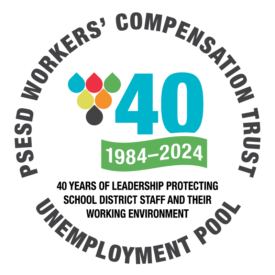
Our highest incidence of on-the-job injuries occur due to trips, slips, and falls, and the end of the school year is a peak period for these types of injuries due to the increase in cleanup and furniture relocation tasks.
Careful thought and planning are needed to develop safe and efficient ways to perform these activities.
Garbage Disposal
Overloading of garbage cans during the end-of-year cleanup presents a major risk of strain and sprain injury for staff moving the bins. Back and shoulder injuries are common due to pushing, pulling, and emptying of heavy wheeled bins.
Here are some strategies to minimize the risk of injury to custodial staff:
- Spread heavy loads equally between bins.
- Consider other waste disposal strategies such as taking garbage directly to industrial bins in manageable loads.
Classroom teachers can play a role in keeping custodians safe during end-of-year cleanup by remembering a few simple tips:
- Undertake a progressive cleanup over the last few weeks of school rather than leaving it to the final days of the school year.
- Do not overfill waste paper bins—remember small baskets are expected to be light when lifted. Placing heavy books or items in these bins increases the risk of injury for the person emptying the bin.
- Place waste paper bins on chairs or desks at the end of each day—this saves the custodian from repetitive bending.
Relocation of Furniture and Equipment
At the end of the school year teachers are frequently asked to ‘relocate’ classroom furniture. Teachers are not furniture movers and often do not have appropriate equipment, assistance, time, or training to complete these tasks safely.
Any tasks involving heavy or awkward loads should only be carried out after thoughtful planning and assessment of risks. The risk of injury can be minimized by:
- Eliminating movement of furniture and equipment when possible.
- Leaving full filing cabinets where they are – only move files in small bundles.
- Moving personal items with the assistance of others. Think about moving only personal items rather than desks and filing cabinets.
- Using professionals to move heavy items. This is efficient and inexpensive when compared to the human and financial costs of an injury to a staff member.
- Planning moving activities like any other major project. The people involved such as the school officer and custodian, need to be consulted.
It is important to ensure an adequate number of staff are available to assist on moving days. Necessary moving equipment must be available and staff must be trained on how to use it.
Simple Safety Tips
Staff should be reminded that their own safety is important, especially toward the end of the school year when there is an even greater temptation to rush to achieve deadlines.
- Work with colleagues and administrators whenever possible to manage major tasks such as relocation of classrooms.
- Plan the task. Take five minutes to think about the best and safest way to do the job: organize assistance, get the right equipment, and clear pathways.
- Ask for help; there is a big difference between what you can lift and what you can safely lift.
- Use the right equipment for the job. This equipment must be easily accessible and in good working order. For example: use a small step ladder to reach items, do not stand on a chair or desk.
- Spread physical tasks over a number of days and allow your body to “warm up” in the morning before starting any heavy lifting tasks.
- Wear appropriate clothing and footwear for the job: bring spare “work” clothes and suitable footwear for moving or “cleanup” days.
- Don’t rush; spending the school holidays recovering from an injury will not be worth the five minutes you might save.
Follow these tips to ensure a safe end to your year!



